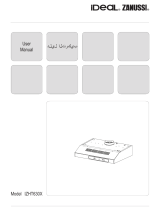
3
2.3-Wall mounting
a - Drill two Ø 8 mm holes on the wall using the paper template, insert two rawl plugs and two 4.2
x 44,4 mm screws leaving 5 mm untightened. Open the metal grille panel, hook the hood on and fully
tighten the screws.
b - If the hood is not provided with a paper fixing template, drill two Ø 8 mm holes (see draw.), insert
the plugs and screws, proceeding as directed under paragraph a.
c - For wall mounting using wallbrackets (optional), follow the instructions of the fixing template.
d-Pay attention to the safety regulation of point 1.6.
2.4-Choice of operating mode
a - Evacuation mode
To check that the hood is set up for evacuation, open the grille panel and make sure that the conver-
sion lever or the change-over knob on the centrifugal unit is in the DUCTING position. The charcoal
filter is not required.
For ducting to the outside, the hood is supplied with a rear and top outlet. A flange spigot of 100 mm
diameter (120 mm in certain models) is usually fitted on the top outlet and a blanking plug on the rear
outlet. If you choose to duct the hood from the rear of the casing, you should invert the position of
the flange and of the blanking plug. Pay attention to the safety regu-lation 1.1.
b - Internal recirculation mode
To check that the hood is set up for recycling, open the grille panel and make sure that the conversion
lever or the change-over knob on the centrifugal unit is in the RECYCLING position.
The charcoal filter is to be fitted. To fit the charcoal filter, support the filter with one hand and turn
the thumb screw through the centre of the charcoal filter. If the filter is of the interlocking type, turn
the filter clockwise. The hood can remain connected to the outside.
2.5-Electrical connection and working test
1 - The safety measures 1.2, 1.3, 1.4 and 1.5 of paragraph 1 are to be strictly observed.
2 - Once the electrical connection has been completed, check that the worktop illumination, motor
and speeds work properly.
3-OPERATION
3.1-Controls are located on the right hand side of the front to operate worktop illumination and select the
most suitable working speed for your cooking. To increase the area of extraction, the glass visor
should be pulled open. The top speed should be used when frying or cooking foods with strong
odours, while a lower speed can be used for normal cooking.
To obtain the best performance from your hood, turn it on before you start cooking and leave it
running for a few minutes after your cooking is over to clear the air.
3.2-Pay attention to safety regulations 1.7 and 1.8.
4-MAINTENANCE AND CLEANING
Regular maintenance and cleaning will ensure good performance and reliability, while exten-ding the
working-life of the hood. Special attention should be reserved to the grease filter and to the charcoal
filter (recycling mode).
4.1-Grease filter
This retains the solid grease particles and can be supplied in different types. lt is fitted onto the reverse
side of the metal grille panel.
Maintenance of the grease filter varies according to the used type.
a - Whatever type of filters used, the filter is easily removed from the grille by pushing the metal wire
clips to one side and removing.
b - Thin synthetic filter (1 mm thick). It should not be washed and should be replaced every two
months. If the filter is provided with a saturation indicator, replace when:
b.1 - The violet colour of the dots, which are visible through the metal grille, is spread over the
whole surface of the filter.
b.2 - The red colour of the stripes, which is not visible through the metal grille when the filter





